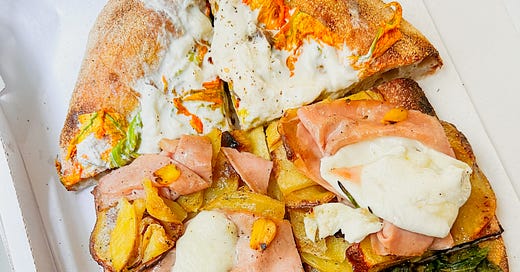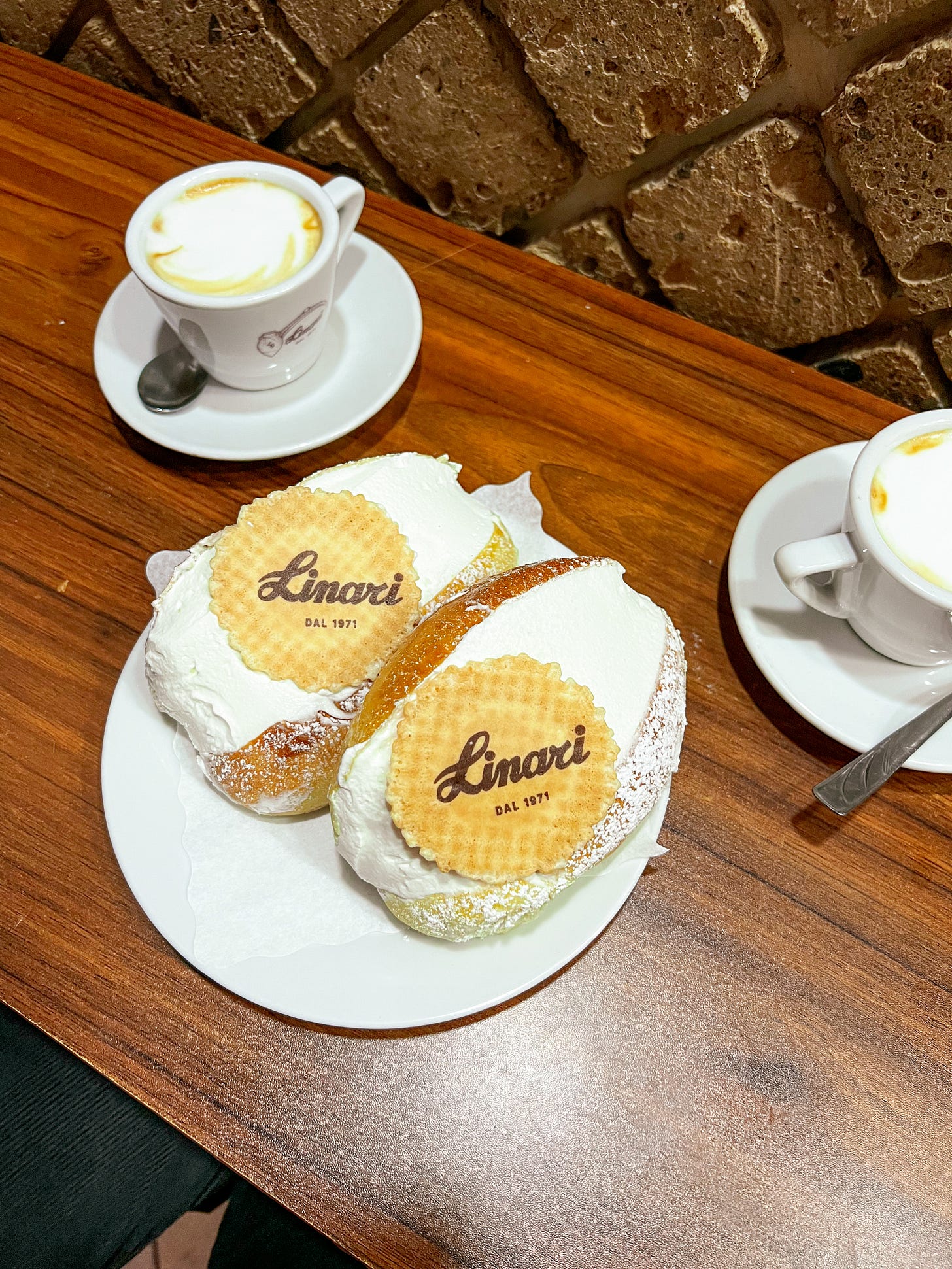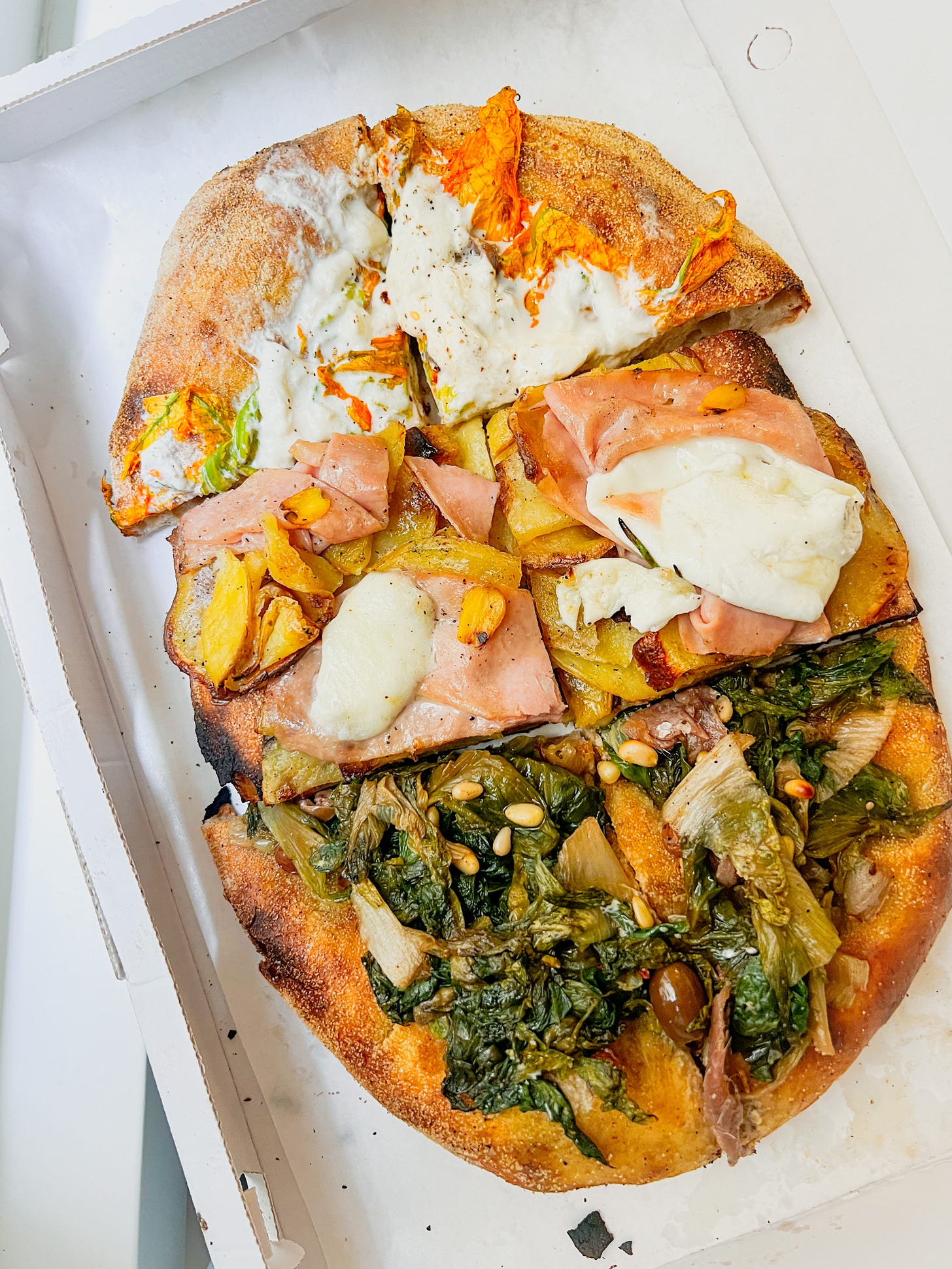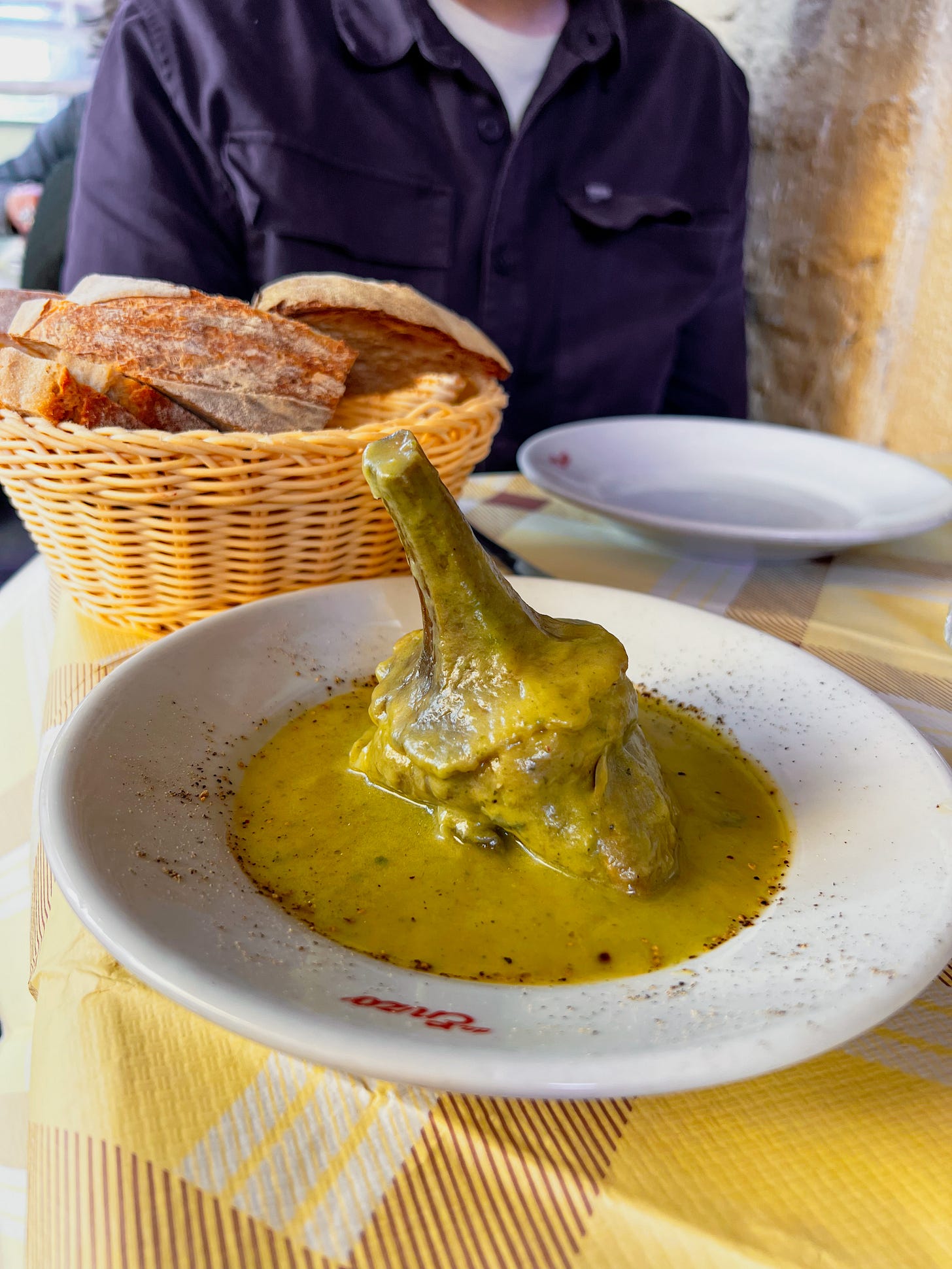It has been an amazing start to our time in Italy. The first almost two weeks in Rome has absolutely flown by but at the same time has felt really relaxed. While I’ve been continuing to work - something that I’m only doing for our first month here, Isaac has taken the opportunity to explore different neighbourhoods in the city through long (read: marathon) walks every day.
We’ve done a lot of cooking at the apartment, which has made the meals we have eaten out that much more special. I’ve put together a list of some of our favourite foods so far, as well as where we ate. We are not fine dining people – although we can appreciate fancy restaurants and degustation menu’s, it never really trumps a plate of simple pasta, a panino, or the type of place you can go to in jeans and a t-shirt with butcher’s paper tablecloths. There may be the odd recommendation for a more high-end place to eat, but most of the time it will be on the casual side. You’ll see that a lot are around Testaccio, where we are staying, but over the next few weeks we will endeavour to get out to some other areas as well and include them here.
A lot of the food guides I’ve seen are evangelical about where, or more importantly, where not to eat, especially if you are a tourist. In our numerous trips to Italy we have definitely eaten at some of the more touristy places because, news flash, we have been tourists! The closer you are to the city centre or the major sites, the more of these types of restaurants you will find. Don’t sweat it if that’s the most convenient place for you to eat – but if you do a little research you can find much more authentic places to eat true Roman cuisine. That being said, you can definitely use your time much more wisely than spending hours a day on Tripadvisor or lining up at the latest TikTok trend place (in most cases!)
1. Maritozzo
Picture this: an enriched bun (kind of like a brioche); not overly sweet; firmer than what you are probably used to. Take a knife and slice it down the middle, but not all the way through. Open it up and fill with the most deliciously light whipped cream you can think of. Finish with a light dusting of icing sugar. This, is a Maritozzo. Perfect for breakfast with un cappuccino scuro (while ‘scuro’ translates to ‘dark’, this is how we order a strong coffee in Italy since our first visit in 2009 – it has never failed us).
We’ve seen these all across Rome’s pasticcerias. So far our favourite has been from Pasticceria Linari in Testaccio, but we also really loved the Maritozzi from Il Maritozzaro just over the river, which is open almost 24/7 (its closed from 7PM Sunday to 6PM Monday). You’ll see them priced from €2.50 and above – we haven’t paid more than that so far, although the closer you are to the historical centre the higher the price is likely to be.
2. Pizza al taglio
Pizza al Taglio, literally, ‘pizza by the slice’ is a type of pizza which originated in Rome but has now spread throughout Italy. Very different to the type of pizza we are used to in Australia (and maybe where you are from too!), this pizza is baked in large rectangular trays, and is sold by weight – the price often being displayed in units of /100g or /Kg. This is not the type of pizza you pick from a menu and they make it to order – the offerings are based on what they have decided to make that day, and you order ‘this much’ or ‘this much’ depending on how much you would like. If you go around lunchtime, you will have the widest variety to pick from.
The base is thick, airy, and made with a coarse flour, and had the most unbelievable crunch to it. It is similar to focaccia. The variety of toppings/flavours were to die for. We went to a very well-known place in the Testaccio market, Casa Manco and got:
- Zucchini flowers with burrata and anchovies
- Mortadella with potato and rosemary
- Seasonal greens with pine nuts, grapes, olives and anchovies
The staff were super friendly, took their time explaining the toppings to customers, and also warned a German tourist that Chinotto isn’t exactly a citrus soft drink like he might be used to (if you know you know!). For enough for lunch for both of us it was around €12.
3. Carciofi
If you’ve followed me for a while you may know that I absolutely love carciofi (artichokes) - so much so that I’ve got a tattoo of one. We are fortunate enough to be in Rome while carciofi are in season. Carciofi are loved by Italians, in particular Romans, so much so that they hold a yearly festival in their honour. In 2025, this festival was held in Ladispoli, about an hour from Rome on public transport.
Here the carciofi are famous for being cooked in two different ways; alla giudia and alla romana. Both require careful preparation of the artichoke to remove the tough outer leaves.
Carciofo alla giudia, or the Jewish style, is fried twice. The first is at a low heat to soften the artichoke, and then a second time at high heat to make it super crispy on the outside. Finished with a sprinkle of sea salt, this dish is a great appetiser to start your meal with. We ate this at Piatto Romano in Testaccio, which I would highly recommend for just about everything on their menu that we tried.
Carciofo alla romana, or the Roman style, is typically braised in a mixture of garlic, herbs, olive oil and white wine. We had this as a starter before tucking in to a meal of rich Carbonara at Da Enzo al 29 in Trastevere (see below).
4. Carbonara
Carbonara pretty much speaks for itself. A simple, but rich pasta dish with undetermined origins but typically known to come from the Lazio region around WWII. Eggs, Guanciale, Pecorino Romano, salt and pepper come together into a creamy, fatty, deliciously glossy sauce which coats the pasta and pleases the eye (and the stomach). Sure there are many variations to this dish – although I still can’t get on board with anybody putting cream into carbonara, but nothing beats the original. I’m certainly looking forward to having this a few more times in Rome and will come back with my most favourite at the end of our time here.
We had this for lunch on our first proper day in Rome at Da Enzo al 29 in Trastevere. While this restaurant is well known on social media, resulting in some seriously long wait times – it is well worth it. If you get there on a weekday approximately 20 minutes before opening you might end up right at the front of the line. Weekends will likely be more popular, but on a previous visit they came and let the line order drinks while we waited. An Aperol spritz on warm day was the perfect combination to prepare us for such a delicious lunch.
It is an excellent Carbonara. Is it the best in Rome? Who knows – I haven’t tried them all yet. For around €15 for a plate of pasta, it is a great way to ease yourself into Rome, especially if you’re trying to eat at a more neighbourhood style restaurant and are not confident with the Italian language – as they do have English menus and some of the staff speak English.
An honourable mention goes to Cantina e Cucina, near Centro Storico (the historical centre), where we’ve been to on previous trips to Rome.
5. Pizza Romana
Roman style pizza is sometimes called pizza tonda, to differentiate it from pizza al taglio. In Italian, tonda means round. So the literal translation of pizza tonda is round pizza. You might think “well, isn’t all pizza round?”, which is a fair question, considering pretty much all the pizza we have in Australia is round, whether it’s a wood-fired Neapolitan style pizza or something from the local pizza place (in our house we call this “shitty pizza shop pizza”, which is not really shitty at all!).
The pizza Romana that we’ve eaten so far is a style of pizza with a very thin crust, cooked very quickly to ensure the base does not burn, and is served in many restaurants in Rome and throughout Italy. It differs from Neapolitan style pizza in that it does not have a raised crust around the outside.
Right near the apartment is Pizzeria Remo a Testaccio. It is a no-nonsense, casual pizza place with plenty of outdoor dining and a great ordering system: when seated we were given a slip of paper that had the entire menu on it, and all you have to do is mark what you wanted to order. Pizza and a drink will set you back no more than €15 per person. The place gets really busy and is full late into the night - still pumping after 11pm, which is a great sign in my opinion. You might find the no-fuss service different to what you’re used to – these guys are doing their job, and they do it well. Don’t come here expecting to be waited on hand-and-foot.
We got one pizze bianche (white base): fiori di zucca - zucchini flowers, anchovies, and one pizze rosse (tomato based): remo - mushrooms, eggplant, sausage. Both were incredible but we agreed that the fiori di zucca was our favourite, and we’re looking forward to trying more.
6. Pejata
Recommended by my friend Maria Pasquale (@heartrome), after confirming that we were open to eating offal (when in Rome, right?), Rigatoni con la Pejata was one of the most interesting and delicious meals we’ve had on this trip so far. Some of the most delicious things we have eaten during our travels in the past have been offal, Kokarec in Turkey, chicken hearts in Spain, haggis in Scotland, and blood sausage in Portugal (while not strictly Offal, it is a close relative).
The main element of this dish, which is distinctly Roman, is intestine of unweaned calf: a by-product of the veal industry. As they are unweaned, they only have milk in their stomach and intestines which resembles ricotta cheese once cooked, inside a ‘sausage casing’. This was served in a simple tomato sauce with rigatoni. I know offal is not for everyone, and certainly not veal offal, but it’s important to recognise that in Italy and much of the world, where possible, as much of the animal – if it is being used for human consumption- is used and not wasted.
We had this at Piatto Romano, where we also had the most amazing carciofo alla giudia, along with some amazing salads, rabbit, and dessert (try the Roman Forest or the Ricotta and Chocolate pie). Pasta dishes here were €12-15 per plate.
7. Panino
In my opinion one of the best quick lunches you can get in Italy, or anywhere really, is a panino. So many cultures have their version of a sandwich, but honestly I think the Italian variety is one of the best. I’m not sure if it’s the bread, or the fillings, or both, but almost every panino I’ve ever had in Italy trumps sandwiches I’ve had anywhere in the Anglosphere.
At the Testaccio market we went to Mordi e Vai, which was recommended to us by so many people. We got vitelli e carciofi (no.8 on the menu - veal and artichoke), and vitella al ragu bianco (no.7 on the menu – white ragu) and a couple of beers. If you go for no.7 definitely say yes to the offer of pecorino romano on top. The toppings were absolutely perfect; moreish, perfectly seasoned and with plenty of sauce to soak into the ciabatta roll to make it soft. Their menu items have clearly been perfected.
If you like beer, try Ichnusa non filtrata or Messina Cristalli di Sale for something different (we fell in love with these beers in Sardinia and Sicily last trip) to the Italian beer you may have tasted before. A panino and a beer will set you back €10 or so.
8. Gelato
It wouldn’t be a trip to Italy without having gelati as often as possible, would it?! You’ll find gelaterias everywhere, and to be honest, we haven’t really ever had a bad one. We’ve had some amazing gelato all across Italy. As for the ‘not-so-amazing’ gelato, well…it’s still pretty good. My personal favourite, which is not to say it is the best, is Grom. I had it for the first time in 2009 when this was our first trip overseas, and I’m still nostalgic for the flavour Crema come una volta (‘custard like once upon a time’). You’ll find Grom across Rome and Italy, and while it is a chain – in my opinion it is delicious. It is a bit more expensive than smaller places (around €5 vs <€4 for a medium cone), but worth trying once at least.
Right near us is Futura Gelateria in Testaccio, which has the traditional flavours and a whole heap of modern options that were super delicious. One of Isaac’s favourites was tutto per me, and for me cremino and fior di bufula. The buffalo milk flavour was mild and moreish.
An easy phrase to learn in Italian, which I’m sure the server will appreciate after hearing countless rude tourists speak unnecessarily loudly entirely in English (even if you butcher it!) is:
Prendo un cono medio, con [flavour 1] e [flavour 2], per favore. Don’t forget to say “grazie” either!
Ok I think that’s everything for now, no doubt I’ll see you next week for another instalment of Roman eats!
Mel x








